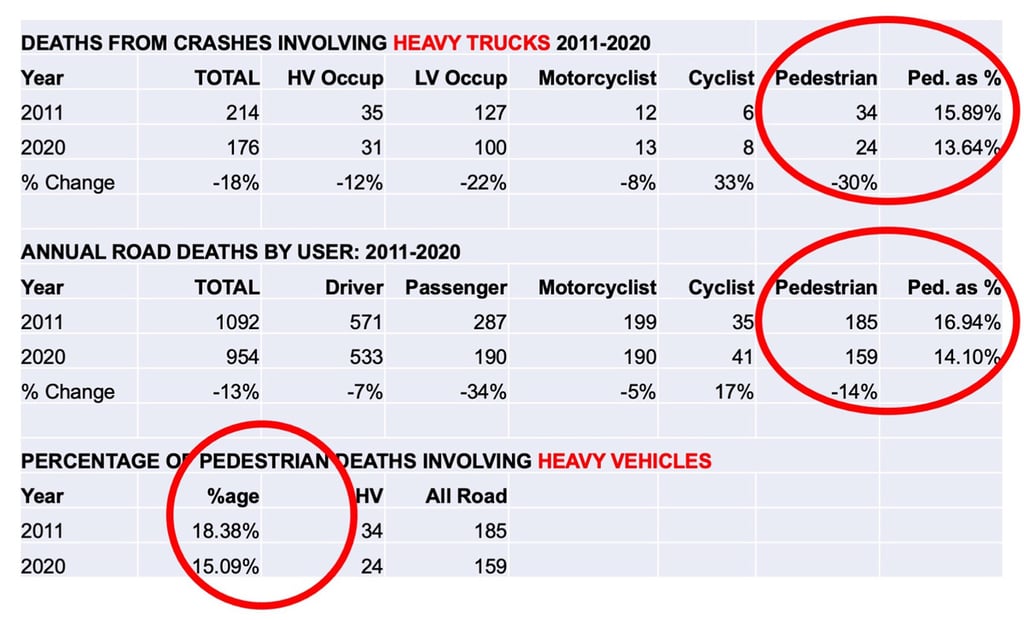PEDESTRIAN PROTECTION
SOLUTIONS TO SAVE PEDESTRIANS FROM BEING KILLED OR INJURED
Pedestrian protection is increasingly a safety concern for many organisations in light of figures which continue to show pedestrian fatalities around 15% of Australia’s road toll.
One in seven pedestrian deaths are the result of collisions with a heavy vehicle and most pedestrians are killed when vehicles are driving at low-speed – highlighting that vehicle design and blind spots are major causes.
SGEGSO-MAX offers a range of pedestrian protection solutions for heavy vehicles that will protect pedestrians and other vulnerable road users: motorcyclists and cyclists.
Why – more than ever – is Pedestrian Protection paramount?
There are a number of factors as to why there are more pedestrians on or near our roads, more pedestrians at risk and more government regulations.
More People living in Australian Cities
Since the 1960s, Australia’s urbanisation rate has consistently been above 80% reaching 86.36 % in 2021. Today, 55% of the world’s population lives in urban areas – Australia is one of the most urbanised countries, due to our high rates of immigration. This has changed our cities with peri-urban agriculture happening around city outskirts being transported into our metro areas, rather than a percentage of our food grown at home, as was the case 60 years ago.
 Governments Encouraging People to Walk & Use Public Transport
Governments Encouraging People to Walk & Use Public Transport
Governments continue to advocate for people to walk and use public transport to reduce congestions on city roads and help lower carbon emissions in the interest of minimising global warming. NSW State Government’s Transport Yourself is one such campaign.
Young Adults Driving Less, Taking Public Transport More
A 2015 Study from Monash University found licensing rates for people under 25 in Victoria had fallen from 77% to 66% since 2001. Other states have similar trends, as do many countries including US, Canada, UK, Japan and much of Europe.
This decline is attributed to several factors, including the cost of car travel, lifestyle changes and better public transport.
Young people now dominate public transport patronage, while at the same time fewer have an understanding of the dynamics of driving a vehicle. And, with modern technology, they are likely to be more distracted when out and about.
While 17 to 25-year-olds are the second-highest age bracket impacted by road deaths, much of this due to speeding. Statistics aren’t available on the age of pedestrians killed but it is likely to become a measurement in coming years.
Pedestrian Deaths in Australia Too High
Whether you are looking at pedestrian deaths caused by cars or heavy vehicles, the statistics are alarmingly high, often hovering around 15%. And while car vehicle safety devices have reduced the incidence of injury and death to vehicle occupants, there is little that protects pedestrians from being hit.
These figures show 2011 and 2020 – a year when there was far less vehicles and people on the road due to Covid-19. (Stats for every year from 2008 can be found here.)

Low Vehicle Speed, Heavy Vehicles Major Factors
As per the above figures, 1 in 7 (more than 15%) pedestrian deaths involve a HEAVY VEHICLE, while heavy vehicles only account for less than 3% of Australia’s 20 million road fleet.
And, 70% of pedestrian deaths happened when vehicles were doing less than 60 kmh. Source. So, heavy vehicles are disproportionately involved in pedestrian injury and death, with much of this happening at low speeds.
Global Trends Influence New UN Regulations
Nearly all of these factors are the same the world over. Numerous reports have shown that drivers cannot fully see all areas around their vehicles by looking at conventional mirrors, or through windows. This is the case for passenger cars, light trucks and moreso for heavy vehicles that have greater blind spots due to their elevation, size, blocked rear view and other factors limiting visibility. Clear visibility is a risk factor when vehicles take off from a stationary position or go straight at low speed (below 20km/h).
As a result of this, and with the advance of cameras and other sensors, the UN has introduced successive regulations in 2018, 2021 and 2022 for countries to adopt, in particular with reference to heavy vehicles, direct vision, and pedestrians and cyclists.
YOU CAN READ MORE ABOUT HOW THIS IMPACTS AUSTRALIA AND TRUCK VISIBILITY HERE.
OUR SOLUTIONS:
SGESCO-MAX Solutions can save Pedestrians and Companies
The great news is SGESCO-MAX has a range MAX-SAFE solutions for heavy vehicles that uses the latest European technologies to detect and protect pedestrians and comply with these new regulations. These include:
-
MAX-SAFE VISION SOLUTIONS
This range of camera solutions delivers the most advanced vision-based safety available, using AI and Machine Learning (ML). See: Rear View, Corner View, Front View and Side View. They give drivers and fleet managers greater confidence knowing drivers can see everything around their vehicle. Options also include:
• 360° Birds-eye View
• Vulnerable Road User/Pedestrian Detection
• Single and Multi-Camera options
• Digital Recording & Back to Base options
• Analogue High Definition (AHD), Digital and Thermal Imaging options
• A range of monitor options
-
MAX-SAFE WATCH SOLUTIONS
Our Reverse Watch, Corner Watch, Front Watch and Side Watch use radar sensors to detect and distinguish between inanimate objects and humans, including distinguishing between a pedestrian or a cyclist. They can be set to detect various distances around the vehicle and notify the driver in the Cabin of any VRUs or objects. They can also be integrated with our Active Braking solution to prevent a vehicle from taking off or brake it if it is going less than 10km – before the driver has the opportunity to re-act and brake.
-
MAX-SAFE AUDIBLE WARNING
Our Audio Warning solutions can be played inside and outside of a vehicle when Vulnerable Road Users are detected. It can be paired with Watch and Vision Solutions.

